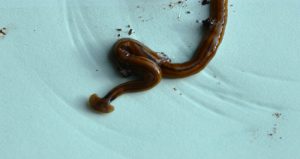Native Plant, Animal and Fungus Species
Florida, including Wakulla County, is home to a wide variety of native plant, animal and fungus species which make up the biosphere. These lifeforms exist collectively and, with the aid of the weather, balance their respective populations by way of utilizing the other species and their byproducts.
The introduction of invasive species from other parts of the world have altered, in extreme cases eliminated, the balance. The local species have little or no way to adapt to these environmental interlopers.
A common trait of exotic invasive species is they leave a visible trail of change and destruction. It is easy to see the results of their presence, in most cases.
Terrestrial Residents Among Us
One exception to the trait of obvious visible presence and damage is the hammerhead flatworm. Classified as a land planarian Bipalium kewense Moseley, as it is scientifically known, is making its presence felt out of the sight of most terrestrial residents.
Land planarians are carnivorous and most species are active predators, with a few species acting mostly as scavengers of recently deceased target invertebrates. In their home ranges, the land planarians’ presence and activity are considered a measure for overall environmental health.

There are over 830 known species, most being found in tropical forest. These settings provide the flatworms plenty to eat and adequate moisture to flourish.
Unfortunately, the international plant trade is thought to have relocated enough of these simple creatures to parts of the world where they becoming a problem for native species. They are frequently found in and around potted plans which have rich soil and earthworms.
Hammerhead Flatworms In Wakulla County
The hammerhead flatworms found in Wakulla County can track their prey, in particular earthworms. Their slow pace and obvious trail easily leads the faster exotic flatworms to its target.
Once the planarian captures the earthworms it uses the muscles in its body, as well as sticky secretions, to prevent escape. The secretions also contain a neurotoxin, tetrodotoxin, employed to subdue its prey.
Unique to land planarian, they propel themselves with what has been described as a creeping sole on their underside. The result is they glide smoothly with a motion similar to many native snakes, and for which they are occasionally mistaken.
Distinctive Shovel Shaped Head
Bipalium kewense can be identified by its dusky pale color, a dark line in the center of its back and running the length of its body and a distinctive shovel shaped head. This species may reach lengths up to five inches.
Land planarians are usually found in dark, cool, moist areas and under objects such as rocks, logs, in leaf litter or under shrubs. They will be seen on the soil’s surface only after heavy rains.
Most of their movement and feeding occurs at night. High humidity is essential to their survival, but they can survive water loss if it does not exceed 45 percent of their body weight.
Avoid This Menu Choice
As with most exotic invasive animal few, if any, local creatures will eat them. In this case it is believed their taste is too offensive for even the most indiscriminate native to consider them a menu selection.
In a twist of irony there is one group of creatures which will eat land planarians, and that is other land planarians. Hopefully, their appetite for the familiar will only intensify.
To learn more about land planarians in Wakulla County, contact your UF/IFAS Wakulla Extension Office at 850-926-3931 or http://wakulla.ifas.ufl.edu/
| The Institute of Food and Agricultural Sciences (IFAS) is an Equal Opportunity Institution authorized to provide research, educational information, and other services only to individuals and institutions that function with non-discrimination with respect to race, creed, color, religion, age, disability, sex, sexual orientation, marital status, national origin, political opinions, or affiliations. U.S. Department of Agriculture, Cooperative Extension Service, University of Florida, IFAS, Florida A&M University Cooperative Extension Program, and Boards of County Commissioners Cooperating. |
 0
0
